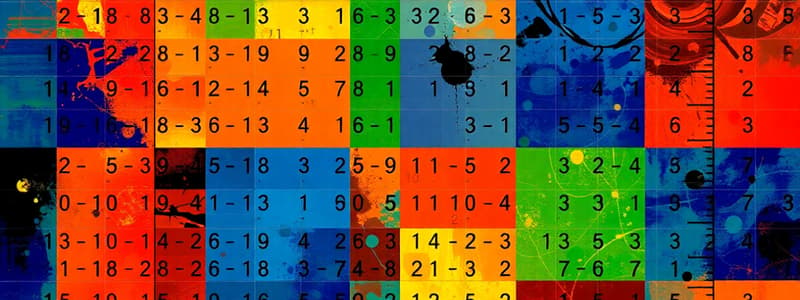Podcast
Questions and Answers
What is the Cayley-Hamilton theorem primarily used for in relation to a matrix A?
What is the Cayley-Hamilton theorem primarily used for in relation to a matrix A?
- To determine the rank of A
- To express A in terms of its characteristic polynomial (correct)
- To find the eigenvalues of A
- To find the inverse of A
When applying the Cayley-Hamilton theorem to the matrix A = [[2, 5], [1, 4]], what is the first step?
When applying the Cayley-Hamilton theorem to the matrix A = [[2, 5], [1, 4]], what is the first step?
- Perform matrix diagonalization
- Compute the characteristic polynomial of A (correct)
- Calculate the determinant of A
- Find the eigenvectors of A
To find the second derivative of the function z = x^3 + y^3 - 3axy, what must you do first?
To find the second derivative of the function z = x^3 + y^3 - 3axy, what must you do first?
- Differentiate z with respect to y, then x
- Apply the product rule to each term
- Differentiate z with respect to x, then y
- Find the first order partial derivatives first (correct)
What is the nth derivative of the function log(x + 3)?
What is the nth derivative of the function log(x + 3)?
If x = r cos(θ) and y = r sin(θ), what does the relationship (∂x/∂r) + (∂y/∂r) equal?
If x = r cos(θ) and y = r sin(θ), what does the relationship (∂x/∂r) + (∂y/∂r) equal?
Verify that the mixed partial derivatives satisfy what relation for the function u = x^3 + y^3 - 3axy?
Verify that the mixed partial derivatives satisfy what relation for the function u = x^3 + y^3 - 3axy?
If u = sin⁻¹(y/x), what is the derivative ∂u/∂x?
If u = sin⁻¹(y/x), what is the derivative ∂u/∂x?
What is the relationship defined by Euler's theorem for a homogeneous function of degree n?
What is the relationship defined by Euler's theorem for a homogeneous function of degree n?
When using polar coordinates, what are the expressions for x and y if x = r cos θ and y = r sin θ?
When using polar coordinates, what are the expressions for x and y if x = r cos θ and y = r sin θ?
What is the result of the expression $x \frac{\partial u}{\partial x} + y \frac{\partial u}{\partial y}$ when u = log( (x+y)/(x-y))?
What is the result of the expression $x \frac{\partial u}{\partial x} + y \frac{\partial u}{\partial y}$ when u = log( (x+y)/(x-y))?
In the context of multiple variables, what does the Jacobian determinant represent?
In the context of multiple variables, what does the Jacobian determinant represent?
For the function u = xy^2, what is the result of the mixed partial derivative ∂²u/∂x∂y?
For the function u = xy^2, what is the result of the mixed partial derivative ∂²u/∂x∂y?
Which of the following expressions defines the relationship for homogenous functions in terms of their variables?
Which of the following expressions defines the relationship for homogenous functions in terms of their variables?
In the expression ∂(u,v,w)/∂(x,y,z) for u = xyz, the determinant gives which of the following quantities?
In the expression ∂(u,v,w)/∂(x,y,z) for u = xyz, the determinant gives which of the following quantities?
What pattern can be observed when evaluating an integral that involves sine and cosine over a defined interval?
What pattern can be observed when evaluating an integral that involves sine and cosine over a defined interval?
In the process of evaluating the integral of sin^5(x) in the interval from 0 to π/2, what key aspect is considered?
In the process of evaluating the integral of sin^5(x) in the interval from 0 to π/2, what key aspect is considered?
If $y = a ext{cos}( ext{log} x) + b ext{sin}( ext{log} x)$, what is the form of the equation when finding the derivative?
If $y = a ext{cos}( ext{log} x) + b ext{sin}( ext{log} x)$, what is the form of the equation when finding the derivative?
What result occurs when applying Leibniz's Theorem to $x e^y$?
What result occurs when applying Leibniz's Theorem to $x e^y$?
For $y = ext{sin}^{-1}(x)$, which expression correctly reflects the nth derivative?
For $y = ext{sin}^{-1}(x)$, which expression correctly reflects the nth derivative?
If $u = ext{log}(
rac{x+y}{x-y})$, what must be shown about the derivatives in relation to $x$ and $y$?
If $u = ext{log}( rac{x+y}{x-y})$, what must be shown about the derivatives in relation to $x$ and $y$?
What does the expression $z = x^2 an^{-1}(x) - y^2 an^{-1}(y)$ express?
What does the expression $z = x^2 an^{-1}(x) - y^2 an^{-1}(y)$ express?
When deriving $y = ext{log}(x + ext{sqrt}(1 + x^2))$, which relationship is expected?
When deriving $y = ext{log}(x + ext{sqrt}(1 + x^2))$, which relationship is expected?
If $cos^{-1}(b) = ext{log}(n)$, which equation must hold true for the derivatives?
If $cos^{-1}(b) = ext{log}(n)$, which equation must hold true for the derivatives?
If $u = ext{sin}^{-1}(
rac{x}{x+y})$, what proves the relationship between derivatives of u with respect to x and y?
If $u = ext{sin}^{-1}( rac{x}{x+y})$, what proves the relationship between derivatives of u with respect to x and y?
Flashcards
Homogeneous function of degree n
Homogeneous function of degree n
A function where replacing x and y with kx and ky respectively results in the function being multiplied by k^n
Euler's theorem for homogeneous functions
Euler's theorem for homogeneous functions
A theorem relating the sum of partial derivatives of a homogeneous function to the function itself
Partial derivatives of homogeneous functions
Partial derivatives of homogeneous functions
Derivatives of a function with respect to one variable, holding others constant
Evaluate definite integral of trigonometric functions
Evaluate definite integral of trigonometric functions
Signup and view all the flashcards
Definite integral of sin^5 x cos^4 x
Definite integral of sin^5 x cos^4 x
Signup and view all the flashcards
Definite integral of sin^7 x cos^5 x
Definite integral of sin^7 x cos^5 x
Signup and view all the flashcards
chain rule
chain rule
Signup and view all the flashcards
Reduction formulas
Reduction formulas
Signup and view all the flashcards
Jacobian determinant
Jacobian determinant
Signup and view all the flashcards
trig identities
trig identities
Signup and view all the flashcards
Nth Derivative of x^n log x
Nth Derivative of x^n log x
Signup and view all the flashcards
Nth Derivative of x^n e^(3ax)
Nth Derivative of x^n e^(3ax)
Signup and view all the flashcards
(1-x^2)y_{n+2} - (2n+1)xy_{n+1} - n^2y_n = 0
(1-x^2)y_{n+2} - (2n+1)xy_{n+1} - n^2y_n = 0
Signup and view all the flashcards
(1+x^2)y_{n+2} + (2n+1)xy_{n+1} + n^2y_n = 0
(1+x^2)y_{n+2} + (2n+1)xy_{n+1} + n^2y_n = 0
Signup and view all the flashcards
x^2 y_{n+2} + (2n+1)xy_{n+1} + 2n^2 y_n = 0
x^2 y_{n+2} + (2n+1)xy_{n+1} + 2n^2 y_n = 0
Signup and view all the flashcards
x^2 y_{n+2} + (2n+1)xy_{n+1} + (n^2 + 1)y_n = 0
x^2 y_{n+2} + (2n+1)xy_{n+1} + (n^2 + 1)y_n = 0
Signup and view all the flashcards
Partial derivative proof
Partial derivative proof
Signup and view all the flashcards
Cayley-Hamilton Theorem
Cayley-Hamilton Theorem
Signup and view all the flashcards
Characteristic Equation
Characteristic Equation
Signup and view all the flashcards
nth Derivative of log(x+3)
nth Derivative of log(x+3)
Signup and view all the flashcards
nth Derivative of ex+4
nth Derivative of ex+4
Signup and view all the flashcards
Partial Derivative
Partial Derivative
Signup and view all the flashcards
Second Order Partial Derivative
Second Order Partial Derivative
Signup and view all the flashcards
Study Notes
Matrices - 2 Marks Questions
-
Reduce matrices to row-reduced echelon form. Examples of matrices are given. Students are asked to reduce these matrices.
-
Find the rank of a matrix. Techniques for reducing to row-reduced echelon form to find the rank are described. Examples of matrices are provided.
-
Solve systems of linear equations. Examples of systems of linear equations are given. Students are asked to solve them.
-
Eigenvalues and eigenvectors. The relationship between eigenvalues of a matrix and its square is demonstrated. This shows how eigenvalues of a matrix relates to its inverse or transpose if the matrix is non-singular. The relationship between eigen values of a matrix and its transpose is elaborated.
-
Cayley-Hamilton theorem. The theorem is stated. Students are asked to verify it for a specific matrix.
Matrices - 5 Marks Questions
-
Find the rank of a matrix. Detailed instructions and examples for finding the rank of matrices using row reduction are given.
-
Rank of a matrix. Methods for finding the rank of a matrix are described. Various example matrices and instructions for finding the rank are given.
Differential Calculus - 2 Marks Questions
-
Higher-order derivatives. Methods for finding nth order derivatives of common functions are demonstrated (e.g., logarithmic functions, exponential functions, trigonometric functions). The example functions include log(x + 3), log(3 - 2x), etc.
-
Partial derivatives. Calculating first and second order partial derivatives of multivariable functions is explained.
-
Chain rule, Implicit differentiation. Formulas and rules for calculating derivatives are given, including examples.
-
Other derivative applications. Instructions and formulas for calculating derivatives using various techniques are detailed.
Differential Calculus - 5 Marks Questions
-
Nth order derivatives of functions. Methods for finding the nth derivative of various functions (e.g., sine, cosine, products of functions) are shown in examples.
-
Leibniz's theorem. The theorem is used for finding derivatives of product functions.
-
Implicit differentiation. Methods for solving for derivatives when functions are defined implicitly, including examples demonstrating how derivative calculation is done when there is a mixture of functions.
Integral Calculus - 2 Marks Questions
- Integration. Evaluating definite integrals of common functions (e.g., sine, cosine, trigonometric functions) over specific intervals (e.g., π/2) is described. Simple example integrals are given, students are expected to resolve these calculations.
Integral Calculus - 5 Marks Questions
-
Definite integrals. Formulas and instructions for calculating definite integrals of various functions over predefined limits are provided.
-
Applications of Integration. Formulas and procedures for calculating areas under curves, surface area and volumes of revolution are detailed.
Analytical Geometry - 2 Marks Questions
-
Spheres. Equations of spheres, centers, and radii of spheres are covered, including equations given. Procedures and steps for resolving spherical calculations are shown.
-
Cones. Equations of cones, properties, and specific parameters are explained. Equations are given for calculation purpose.
-
Circles, cylinders, Formulas and procedures for calculations.
Analytical Geometry - 5 Marks Questions
- Spheres. More complex concepts and calculations related to spheres, tangent planes, and common applications are demonstrated, step by step.
- Cylinders and Cones. Comprehensive equations, explanations, and procedures are given for cylinders and cones, including normal sections and various parameter-finding techniques.
- Analytical tools. Methods are given for solving problems related to these figures, including parallel planes, intersecting lines, and coordinates.
Studying That Suits You
Use AI to generate personalized quizzes and flashcards to suit your learning preferences.




